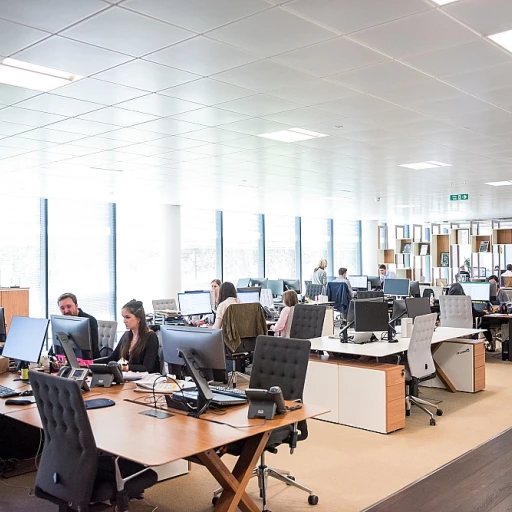The Evolution of Hybrid Work Models
Tracing the Shift to Hybrid Work Models
The way we work has undergone significant changes in recent years. The traditional nine-to-five workday, once tethered to a central office location, has evolved to incorporate more flexible structures. The hybrid work model has become increasingly popular among organizations aiming to meet the diverse needs of their workforce. This shift comes as more employees seek a balance between remote work and in-office collaboration. The hybrid approach lets employees enjoy the autonomy of working remotely while still benefitting from the connectivity and team spirit fostered within a physical workplace. Such a transformation isn't just a logistical adjustment; it is also an operational overhaul necessitating new strategies for ensuring health and safety in work environments. Employers are now tasked with balancing productivity and hybrid work safety measures, all while maintaining employee engagement. As hybrid workers adapt to different environments, safety concerns such as mental health risks, ergonomic challenges, and adequate dse assessments must be addressed. It's crucial for organizations to recognize the potential safety challenges that arise from hybrid working arrangements. Prioritizing both physical and mental health safety can help employers retain a motivated and secure workforce. Successful risk management involves understanding the new dynamics of hybrid workplaces and implementing effective strategies that foster a safe and engaging work environment. More on achieving this balance can be found in the article on balancing employee engagement.Identifying Key Safety Risks in Hybrid Work
Recognizing Significant Safety Challenges
In the evolving landscape of hybrid work, identifying key safety risks is crucial for both employers and employees. A hybrid work environment blends remote work with in-office presence, presenting unique safety challenges that must be addressed.
One major concern involves maintaining health and safety standards both at home and in the office. Employers need to consider home safety assessments, much like DSE assessments in offices, ensures remote workers have a suitable setup to prevent ergonomic issues. Remote working can increase the risk of mental health issues, highlighting the need for appropriate mental health support and training programs.
Workplace safety also encompasses fire safety regulations in hybrid settings. While in-office workers are usually covered by comprehensive safety measures, remote hybrid workers may lack adequate guidance. Organisations must inform employees of essential safety protocols whether they're working remotely or onsite.
Security risks pose another layer of complexity. As employees work from multiple locations, data protection becomes key. It is critical to ensure robust security systems are in place to protect sensitive information across different devices and networks.
The management of these risks requires a strategic approach, focusing on risk management and training. Employers must actively engage in regular assessment and adaptation of safety and health guidelines to address the specific needs of hybrid workers.
Impact on Employee Engagement
The Connection Between Safety and Engagement
In hybrid work models, employee engagement can be influenced by safety concerns. As organizations navigate the challenges of balancing remote and in-office work environments, the safety and health of employees become paramount. When safety risks are present, such as inadequate fire safety measures or insufficient health safety protocols, there is a direct impact on employees' sense of security and their ability to fully engage with their work.Influence on Mental Health and Productivity
Safety risks in hybrid working environments not only affect physical security but can also impact mental health. Concerns over security and health safety can lead to increased stress levels among workers. This, in turn, can decrease productivity and engagement as employees may become preoccupied with potential risks rather than focusing on their tasks. Remote workers, in particular, might face unique challenges like feeling isolated, which further affects their mental well-being and, consequently, their work performance.The Role of Risk Management and Training
Employers have a crucial role in addressing these challenges by implementing robust risk management strategies. Regular safety training and dse assessments can empower employees with the knowledge they need to navigate hybrid workplaces safely. Engaging workers in safety initiatives not only reduces risks but also fosters a culture of trust and support, enhancing their overall engagement. Exploring ways to enhance employee engagement through diversity can further contribute to creating a workplace environment that champions both safety and inclusion, driving engagement across diverse teams.Strategies for Mitigating Safety Risks
Mitigation Strategies for a Safer Hybrid Workplace
With the hybrid work model becoming more prevalent, ensuring the safety of all employees—whether they are working remotely, in the office, or switching between both—is crucial for organizations. Addressing safety concerns requires a multifaceted approach that incorporates both physical and mental well-being, risk management, and proactive training initiatives.
Here are some key strategies that organizations can implement to mitigate safety risks effectively:
- Comprehensive Safety Policies: Develop and communicate clear, comprehensive safety policies tailored to hybrid working conditions. This includes guidelines for remote workers as well as in-office employees to ensure that all health and safety standards are met consistently.
- Conduct Regular Risk Assessments: Implement routine assessments to identify potential workplace hazards. These could cover areas such as DSE assessments for remote setups and fire safety protocols in office environments.
- Invest in Training and Resources: Provide formal training on safety best practices, such as ergonomic setups, mental health awareness, and emergency procedures. Equip employees with resources to manage their work environment effectively, whether at home or in the office.
- Leverage Technology for Safety Monitoring: Utilize technological solutions for continuous safety monitoring and management. Tools that offer security and health safety tracking can help employers stay informed about potential risks and develop better response strategies.
- Promote Mental Health Prioritization: Enhance the focus on mental health by encouraging open communication, offering support resources, and fostering a culture of awareness. Addressing mental health proactively can alleviate stress and improve overall employee engagement.
- Establish Clear Communication Channels: Ensure smooth communication across all levels of the organization. Provide platforms for employees to voice concerns, report safety issues, and access help when required.
By implementing these strategies, organizations can create a hybrid work environment that supports the health and safety of all employees, ultimately leading to a more engaged and productive workforce.
Role of Technology in Ensuring Safety
Leveraging Technology for Enhanced Safety in Hybrid Work
Technology plays a pivotal role in transforming hybrid work environments into safer spaces for employees. As organisations navigate the complexity of hybrid work models, integrating the right technological tools can effectively mitigate safety risks. Firstly, implementing secure communication and collaboration platforms is crucial. These platforms ensure remote workers can connect seamlessly with their counterparts in the office, reducing the risk of security breaches and promoting a secure exchange of information. Another key area is the application of advanced software solutions for health safety. Employers can utilise digital platforms for regular health assessments and training, which are vital for maintaining physical and mental well-being. Tools designed for conducting DSE (Display Screen Equipment) assessments help protect the health of employees working remotely. When it comes to remote work, technology aids in comprehensive risk management. Employers can deploy systems for monitoring workplace conditions and ensuring that both physical and virtual workspaces adhere to safety regulations. AI-driven tools can play a role in predicting potential risks and implementing preventative measures. Moreover, technology aids in the effective management of hybrid workers' welfare by ensuring that mental health resources are easily accessible. Mental health apps and platforms providing virtual therapy or stress management techniques support employees' mental well-being, reducing potential workplace hazards related to stress and burnout. Lastly, emergency preparedness is enhanced through technology. Digital fire safety training and evacuation drills can be conducted remotely, making sure employees remain informed and ready, regardless of their work environment. The successful integration of these technological strategies supports a culture of safety and demonstrates a commitment by employers to protect their workers whether they are in the office or working remotely. This proactive approach ultimately contributes to improved employee engagement and organisational resilience.Creating a Culture of Safety and Engagement
Fostering a Safe and Engaged Work Culture
Creating a culture of safety and engagement within hybrid work environments requires deliberate effort and strategic planning by employers. Hybrid work models, which blend remote and office-based work, present unique challenges in maintaining employee safety and fostering engagement. To address these challenges, organisations can implement a comprehensive approach that integrates safety, health, and engagement practices across all work settings.
First and foremost, safety training should be a continuous effort, ensuring employees are well-versed in the protocols necessary for both remote and office environments. This includes understanding cybersecurity measures for data protection during remote working and traditional fire safety protocols for those in the office. Regular dse assessments and inspections of remote workspaces can help identify and mitigate potential health risks.
Equally important is addressing mental health. Employers should foster an environment where employees feel supported in managing work-related stress, whether they are remote workers or in-office hybrid workers. Promoting open communication and offering mental health resources can significantly contribute to a more engaged and productive workforce.
Management plays a crucial role in driving a safety and engagement-focused culture. Leaders should lead by example, demonstrating a commitment to safety policies and actively seeking employee input on safety concerns. This approach not only reinforces the importance of safety but also empowers employees, boosting their engagement and shared responsibility in maintaining a secure work environment.
Building an organisation's culture around safety and engagement is not a one-time effort. It requires ongoing evaluation and adaptation of strategies to ensure they remain effective in evolving hybrid workplaces. By prioritising both physical and mental safety, employers can cultivate an environment that supports and engages all their workers in remote and office settings alike.


